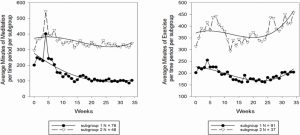Reduce Challenging Behaviors of Adults with Intellectual Disabilities with Mindfulness
By John M. de Castro, Ph.D.
“mindfulness may represent an effective psychoeducational approach for some. . .People with an intellectual disability.” – Tammy-Lee Currie
Intellectual disabilities involve below average intelligence and relatively slow learning. They are quite common, affecting an estimated 10% of individuals worldwide. These disabilities present problems for the individual in learning mathematics, reading and writing. These difficulties, in turn, affect performance in other academic disciplines. The presence of intellectual disabilities can have serious consequences for the psychological well-being of the individual, including their self-esteem and social skills. In addition, anxiety, depression, and conduct disorders often accompany learning disabilities.
Individuals with intellectual disorders often have challenging behaviors including aggression, disruptive and socially inappropriate behaviors, self‐injury and withdrawal behaviors. The challenging behaviors not only reduce the quality of life of the individual but also puts them at higher risk of abuse, neglect, deprivation, institutionalization, and restraints. In addition, caregivers may have to deal with verbal and physical abuse. Obviously, there is a need for therapies that can reduce these behaviors. Mindfulness training may be useful. It has been shown to improve the behavior of individuals with intellectual disabilities. But there is a need to summarize what has been learned about various intervention that do not use drugs.
In today’s Research News article “Non-pharmacological interventions for challenging behaviours of adults with intellectual disabilities: A meta-analysis.” (See summary below or view the full text of the study at: https://www.ncbi.nlm.nih.gov/pmc/articles/PMC7384078/ ) Bruinsma and colleagues review, summarize, and perform a meta-analysis of the effectiveness of non-pharmacological treatments in reducing challenging behaviors in adults with intellectual disabilities. They identified 22 published research studies.
They report that the published research found that there was an overall significant reduction in challenging behaviors produced by non-pharmacological treatments with moderate effect sizes. These effects were found to be lasting, producing improvements 3 to 18 months after the interventions. They also found that interventions that employed behavioral interventions, cognitive behavioral therapy, environment mediated interventions, and randomized controlled trials did not produce superior results compared to all other interventions. But when the intervention contained mindfulness there was a significantly greater reduction in challenging behaviors compared to all other interventions.
These results are interesting and suggest that a variety of different non-pharmacological treatments reduce challenging behaviors in adults with intellectual disabilities. But interventions that teach mindfulness produce superior results. The authors did not speculate as to how mindfulness training amplifies the effectiveness of the interventions. But mindfulness training has been shown to produce relaxation, calmness, improvements in emotion regulation, and reductions in responsiveness to stress and these effects may well underlie the ability of mindfulness training to reduce the challenging behaviors.
The ability of mindfulness training to produce greater reductions in challenging behaviors is very important for the well-being of these adults with intellectual disabilities as these challenging behaviors are problematic. They have damaging, disruptive, and negative effects on the individuals themselves and those around them. The more that these behaviors can be reduced the better for all concerned. Since interventions that contain mindfulness training produce the greatest reductions. They should be the treatments of choice.
So, reduce challenging behaviors of adults with intellectual disabilities with mindfulness.
“mindfulness meditation helps people with intellectual disabilities and autism spectrum disorder reduce their mental and physical problems. . . mindfulness meditation was effective for reducing aggression, both physical and verbal.” – Yoon-Suk Hwang
CMCS – Center for Mindfulness and Contemplative Studies
This and other Contemplative Studies posts are also available on Google+ https://plus.google.com/106784388191201299496/posts and on Twitter @MindfulResearch
Study Summary
Bruinsma, E., van den Hoofdakker, B. J., Groenman, A. P., Hoekstra, P. J., de Kuijper, G. M., Klaver, M., & de Bildt, A. A. (2020). Non-pharmacological interventions for challenging behaviours of adults with intellectual disabilities: A meta-analysis. Journal of intellectual disability research : JIDR, 64(8), 561–578. https://doi.org/10.1111/jir.12736
Abstract
Background
Non‐pharmacological interventions are recommended for the treatment of challenging behaviours in individuals with intellectual disabilities by clinical guidelines. However, evidence for their effectiveness is ambiguous. The aim of the current meta‐analysis is to update the existing evidence, to investigate long‐term outcome, and to examine whether intervention type, delivery mode, and study design were associated with differences in effectiveness.
Method
An electronic search was conducted using the databases Medline, Eric, PsychINFO and Cinahl. Studies with experimental or quasi‐experimental designs were included. We performed an overall random‐effect meta‐analysis and subgroup analyses.
Results
We found a significant moderate overall effect of non‐pharmacological interventions on challenging behaviours (d = 0.573, 95% CI [0.352–0.795]), and this effect appears to be longlasting. Interventions combining mindfulness and behavioural techniques showed to be more effective than other interventions. However, this result should be interpreted with care due to possible overestimation of the subgroup analysis. No differences in effectiveness were found across assessment times, delivery modes or study designs.
Conclusions
Non‐pharmacological interventions appear to be moderately effective on the short and long term in reducing challenging behaviours in adults with intellectual disabilities.
https://www.ncbi.nlm.nih.gov/pmc/articles/PMC7384078/





